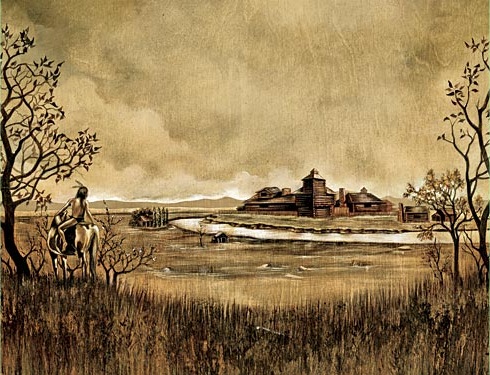Publisher's note: The article below appeared in John Hood's daily column in his publication, the Carolina Journal, which, because of Author / Publisher Hood, is inextricably linked to the John Locke Foundation.
RALEIGH If the
War of 1812 was, as some have described it,
America's first Forgotten War, then the event that occurred 200 years ago today could well be described as a tragically forgotten episode of that war. Even in the present-day city of Chicago, which includes the location of this event, it is either remembered as mythical, eschewed as controversial, or ignored altogether.
The controversy begins with the name. On August 15, 1812, the American garrison of Fort Dearborn surrendered their key stronghold on Lake Michigan to Potawatomi Indians allied with the British. As the small
Chicago, 1812: This illustration is inspired by a diorama from the 1933 Century of Progress Exposition showing the Kinzie house, Fort Dearborn.
column of 55 soldiers, 12 militiamen, 27 women and children, and 30 Miami Indian allies evacuated the fort, headed for Fort Wayne, Indiana, some 400 to 500 Potawatomi waited in ambush behind some dunes. They struck. After a few minutes of combat, the Miami Indians had fled and the Americans had been overwhelmed and either captured or killed.
The Potawatomi described this event as the
Battle of Fort Dearborn. They saw it as a victory in their continuing struggle to resist American encroachments and treaty violations.
The Americans described this event as the
Massacre of Fort Dearborn. They saw it as a case of Indians ambushing a force that had retreated by mutual agreement, after which innocent women and children were bludgeoned to death in cold blood while several of the American soldiers were tortured, executed, and mutilated. Indeed, the heroic head of the escort party, Captain William Wells, was not only killed but had his heart ripped out from him and eaten by several of the victorious Potawatomi.
What really seems to have happened is a
cascade of miscalculations. After America declared war in June 1812, British forces in Canada immediately began to seize key points on the Great Lakes. On July 17, about 600 British regulars, Canadian militia, and Indian allies surrounded Fort Mackinac that lay astride the straits connected Lake Huron and Lake Michigan. The tiny American garrison of 61 soldiers surrendered without firing a shot.
 The present day location of the Battle of Fort Dearborn, August 15, 1812, in Chicago, Illinois: Above and below.
The present day location of the Battle of Fort Dearborn, August 15, 1812, in Chicago, Illinois: Above and below.

The fall of Fort Mackinac made it impossible for the Americans to fortify and supply, and thus to hold, Fort Dearborn, which had been built in 1803 in what is now downtown Chicago. The ranking American commander in the region, General William Hull, was based at Detroit. He issued orders to abandon Fort Dearborn, destroy the arms and ammunition, and offer any other goods to the Indians to ensure safe passage for the garrison and civilians. (The day after Fort Dearborn fell, Hull would surrender Fort Detroit.)
The Americans did as told. But somehow the terms of the deal got lost in translation. The garrison commander, Captain Nathan Heald, thought he had negotiated an honorable surrender with the Potawatomi in which his party would be guaranteed safe passage in exchange for the fort and all the food and trade goods within it. But the Indians later said that they thought the deal also included the fort's stockpile of arms, ammunition, and whiskey - all of which the Americans had destroyed them rather than letting them fall into Indian hands.
What about the massacre? Well, no one denies that a small number of Indians, perhaps just a single Potawatomi warrior, killed most of the women and children hiding in the American wagons. But Indians later argued that those responsible for the massacre were held responsible by their own tribe, and that one of the Potawatomi leaders, Black Partridge, had actually saved the life of the American commander's wife by pretending to drown her in the river.
In retaliation for the massacre, American troops raided Potawatomi villages in the fall of 1812, burning several to the ground, including that of Black Partridge. That transformed him from a sometime-friend of the Americans to a full-fledged ally of the British. As happened several times during the 18th and 19th centuries, however, Indian leaders had chosen the losing side and would pay a stiff price for it.
So, was there a battle or a massacre at Fort Dearborn? I think the answer is obvious. However, I also think that Simon Pokagon, a Potawatomi who lived a couple of generations later, had a point when he said that "when whites are killed, it is a massacre, but when Indians are killed, it is a fight."
Hood is president of the John Locke Foundation and author of
Our Best Foot Forward: An Investment Plan for North Carolina's Economic Recovery.


























